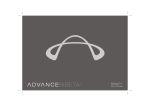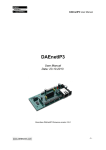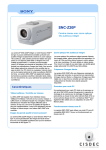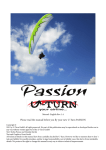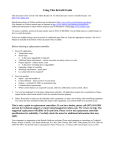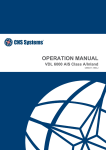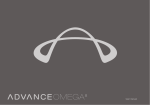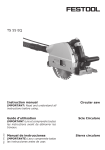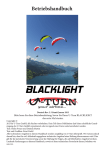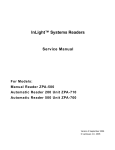Download User manual
Transcript
BIBETA 5 User manual Edition 1 / 05_2012 Contents Thank you for flying ADVANCE ....................................................... 4 About ADVANCE .............................................................................. 5 The BIBETA 5.................................................................................... 6 Share your passion....................................................................... 6 More important details.................................................................. 7 Pilot requirements............................................................................. 9 Using the paraglider for the first time............................................ 10 Delivery....................................................................................... 10 Basic set-up................................................................................ 10 Adjusting the brake lines............................................................. 10 Speed system/Trimmer............................................................... 10 Big Ears System.......................................................................... 12 Fitting the Spreaders................................................................... 12 Suitable harnesses...................................................................... 13 Weight range............................................................................... 13 Flight characteristics...................................................................... 14 Takeoff......................................................................................... 14 Normal flight ............................................................................... 15 Turns ........................................................................................... 15 Accelerated flight........................................................................ 15.. Collapses .................................................................................... 16.. Rapid descents............................................................................17 Stall.............................................................................................. 19 Landing....................................................................................... 20.. Flying with a wet paraglider ....................................................... 20 Winching...................................................................................... 21 Acrobatics................................................................................... 21 Maintenance, repairs and care ...................................................... 22 Packing ....................................................................................... 22 Care and maintenance ............................................................... 22.. What to do if the leading edge gets damaged? ........................ 22 Check ......................................................................................... 23 Repairs........................................................................................ 23 Disposal....................................................................................... 23 Technical details............................................................................. 24 Materials used............................................................................. 25 Certification................................................................................. 26 Service............................................................................................ 27 ADVANCE Service Center.......................................................... 27 The ADVANCE website............................................................... 27 Warranty...................................................................................... 27 List of parts..................................................................................... 30 Line plan ......................................................................................... 31 Risers ............................................................................................. 32 Bowline knots................................................................................. 37 3 Thank you for flying ADVANCE Congratulations on your choice of a BIBETA 5 - a quality product from ADVANCE. We are sure that you will spend many rewarding hours in the air with it. This user manual is an important part of the glider. Here you will find instructions and important information about safety, care of the glider and maintenance, and that’s why we recommend that you read this document carefully before your first flight. The latest version of this manual, as well as further updated information, can be found at www.advance.ch. Any new safety-related information will also be published on the website. If you have any further questions or problems please contact your dealer or get in touch directly with ADVANCE. We wish you a lot of enjoyment with your BIBETA 5 and always «happy landings». Team ADVANCE 4 About ADVANCE ADVANCE, based in Switzerland, is one of the world’s leading paraglider manufacturers. Since it was founded in 1988, the company has consistently pursued its own directions and concepts, both in development and production. The results are quality products with distinctive characteristics. At the heart of the ADVANCE brand is a team of specialists who share the passion of the customers who place their trust in the company’s products. With their thorough understanding of flying they contribute their valuable personal experience and dedication to the working processes. Total control of the production process and supervision of the working practices at the ADVANCE factory in Vietnam ensure a high standard of workmanship. Long term relationships with fabric and line manufacturers means that ADVANCE knowledge and expertise also finds its way directly into the development of new materials. ADVANCE attaches great importance to after-sales customer support, and has built up a worldwide service network for this purpose. An on-going interaction with its customers brings in a steady flow of new knowledge that finds its way into ADVANCE products, thus completing the «Circle of Service». 5 The BIBETA 5 BIBETA 5 – Share your passion Resistant You want to take off effortlessly with your passenger for a stress-free flying experience? The BIBETA 5 can fully satisfy this requirement. Its excellent takeoff behaviour as well as efficient turning flight and landing identify the BIBETA 5 as an absolutely reliable partner. The BIBETA 5 is a reliable and hard-wearing partner. The optimised internal structure combined with a careful choice of materials make the BIBETA 5 a light but robust and long-lived wing that will, even after frequent use, remain hard-wearing, retaining its takeoff qualities and canopy stability. Outstanding characteristics Stress-free Just a brief impulse and already the canopy is climbing evenly above you and your guest – the BIBETA 5’s easy inflating and rising mean that you and your passenger leave the ground in a relaxed frame of mind, ready to enjoy the flight. Even in difficult takeoff conditions the BIBETA 5 is a partner which you can fully rely on. Efficient The BIBETA 5’s internal conformation has been further improved by means of detailed analysis and calculation: the weight-efficient structure and the use of Nylon wires make the wing lighter. Equipped with performance-enhancing trimmers and the established Vary-Grip big ears system the BIBETA 5 stands for efficiency and precision. 6 More important details Effective Trimmers STRESS-FREE The BIBETA 5 has an accelerate system that uses trimmers. These trimmers, with very long travel, expand the operating envelope, and achieve a speed increase of approx. 5km/h. They provide a higher safety margin in strong winds, and increase the glider’s usefulness with lighter passengers. And, not least, the use of trim together with big ears (Vary-Grip-System) is also, for the passenger, a very comfortable and considerate way of descending. Spreaders adjustable for height EFFICIENT The BIBETA 5 is delivered with hard, soft or soft adjustable spreaders. The adjustable soft supports are infinitely variable to accommodate different passenger sizes. Clever design means that these can be adjusted in flight. ADVANCE Innovations & Quality RESISTANT ADVANCE pay a lot of attention to small details. Sewn-in tension bands improve canopy stability, distinctive winglets reduce induced drag (vortex-effect). Velcros at the wingtips make it easy to remove 7 sand and snow etc from the wing. Like all ADVANCE models the BIBETA 5 comes with swivels and magnetic clips on the brake handles as standard. All these small but important details finish off the product. Pilot requirements Flying a paraglider calls for appropriate training and a sound knowledge of the subject, and of course the requisite insurance cover and licences. A tandem pilot must be able to correctly assess the meteorological conditions before taking off. His or her capabilities must match the responsibilities of tandem flying. The wearing of an adequate helmet, suitable shoes and clothing of pilot and passenger as well as carrying an emergency reserve parachute are indispensable. All components of the equipment must be checked for damage and airworthiness before every flight. A thorough pre-flight check should also be carried out. Each pilot bears sole responsibility when making a tandem flight. Neither the manufacturer nor the seller of a paraglider can guarantee, or be held responsible for, the safety of pilot and passenger. 9 Using the paraglider for the first time Delivery Adjustment of the brake lines Each ADVANCE paraglider must be flown by the dealer and checked for correct basic setting and trim. After doing this the dealer enters the date of the first flight on the manufacturer’s label fixed to the rib in the centre of the canopy. This entry, together with the return of a correctly completed warranty card to ADVANCE, will ensure that defects in the product attributable to a manufacturing fault are covered by the ADVANCE warranty (see Warranty in the «Service» section). The brake line length is set at the factory so that the trailing edge is unbraked (crease-free) in fully accelerated flight with brakes fully released. Fundamentally this setting should be kept. BIBETA 5 delivery includes a backpack, an inner bag, a compression strap, hard or soft spreaders (the soft spreaders are continuously adjustable for height), a repair kit, a mini windsock in the colours of the wing and a “Getting-started” booklet. Basic set-up The basic set-up of the BIBETA 5 at delivery is that which has been found to be ideal by the ADVANCE test team; it is in this condition that the glider was awarded its certification. Any unapproved changes or modifications, such as changes to the line lengths or the attachment of other risers or quick links by the owner, will result in the paraglider losing its certification (see the «Certification» section). If the brake lines have to be reset there must be approx. 10 – 12cm free line movement (at the pulleys) between brakes fully released and that brake position that first affects the trailing edge in unaccelerated flight. We recommend that the brake handles are secured using a bowline knot (see illustration in the appendix page 39). Speed system/Trimmer The BIBETA 5 has an accelerate system in the form of trim. It is very effective and easy to use. It provides for a significant increase in speed of ca. 5 km/h. The BIBETA 5 accelerate system is not only intended to provide a better performance reserve for dealing with strong winds (e.g. slope soaring, strong valley winds), but it also increases the glider’s general user-friendliness, mainly when carrying light passengers. In addition, when used with big ears (Vary-Grip-System), the trim improves the 10 1 most agreeable way of getting down if passenger well-being requires it (see also section «Fast Descent»). 2 In accelerated flight the rear risers are lengthened and this reduces the angle of attack of the wing. The accelerate system on the BIBETA 5 is so designed that the wing profile remains the same in accelerated flight (reduced angle of attack). This keeps the best wing shape at higher speeds. The trimmers do not require adjustment. Just make sure that they are closed before takeoff (neutral position i.e. unaccelerated). To open them in the air press both spring clips on the back of the risers at the same time (see point 2 ); you can set any trim position as you wish using these clips. They will not slip even under extreme load. To close the trimmers pull the lower tapes down as far as possible using the blue loops. Caution: Keep the trimmer settings symmetrical. Caution: When the trimmers are open the brake handles will be in a noticeably higher position than in unaccelerated (normal) flight. 11 Big Ears System The BIBETA 5 has split A-risers, which make the application of big ears easy. A cleat (Vary-Grip-System) makes it possible to fix the outer A-lines so that they can be held in for an extended period. (see point 1 ). The lines can be pulled down and reset in the clamps. With big ears applied the glider can be steered normally using the brakes. 1 Fitting the Spreaders The BIBETA 5 comes with hard, soft or soft adjustable spreaders. The hard spreaders hold a spread distance of 27 cm. The passenger can be suspended from two different positions. The reserve bridle runs above the pilot’s own spreader arm and is fixed in the middle of the support, next to the main glider suspension point. The soft spreaders have a length of 70 cm. There are three possible positions to which to connect the paraglider riser. The reserve bridle runs underneath the pilot’s spreader arm and is fixed on the loop provided. 12 The soft adjustable spreaders have a length of 70 cm. There are two different positions to which to connect the paraglider riser. There is a spring-loaded cleat (see point 9 Riser Illustration page 33) on the pilot’s spreader arm, which allow him to adjust the support height to suit the passenger size. The reserve bridle runs underneath the pilot’s spreader arm and is fixed on the loop provided. Tip: The soft adjustable spreaders can be adjusted to any position to suit the passenger height. If you have trouble shortening them in flight you can pull the straps down with the loops bit by bit, alternating left and right, and weight-shifting to the opposite sides, thus reducing the force required. includes the pilot’s and passenger’s body weights, clothes, and the weight of all equipment (paraglider, harnesses, instruments etc.) – in fact everything that’s going on the flight. The BIBETA 5 is certified for a takeoff weights between 120 kg to 225 kg. The best weight range lies between 150 kg and 190 kg. Flight at the lower and upper weight limits can affect speed and glider flying behaviour; without, however, influencing the safety of pilot and passenger. Suitable harnesses The BIBETA 5 is certified for use with harnesses without rigid crossbracing (see section “Certification”). The main support points of the selected harness should (ideally) be set at a distance of approx. 45 cm and a height of 40 to 45 cm. Weight range The BIBETA 5 weight range is shown in the «Technical Data» section. The figures given there represent total in-flight weight. This, of course, 13 Flight characteristics We recommend that you make your first flights with the new glider in quiet conditions at a familiar flying site, so that you can gain confidence in your BIBETA 5 from the outset. Tip: To get the BIBETA 5 in just the right curved shape for takeoff stand abeam the centre of each wing after you have sorted the lines; take the brake line and pull it in until all the brake junctions are tensioned. Takeoff Light Wind Takeoff (Forwards) Before every takeoff carry out the following pre-takeoff checks: 1. Harnesses and helmets done up, reserve OK? 2. Pilot-glider-passenger connections OK? 3. Lines free? 4. Canopy open? 5. Wind direction and strength assessed? 6. Airspace and view clear? 7. Passenger ready? BIBETA 5 takeoff behaviour is very smooth and straightforward for both forward and backward launches. Nylon wires and light weight ensure that the canopy fills quickly and climbs evenly, without hanging or shooting ahead. The BIBETA 5 is pulled up using both the inner, wide A-risers. This takes less effort, and the wing will come up very straight. The canopy should always be laid out in a slightly curved shape, so that all A-lines are equally loaded during the pull up. The BIBETA 5 only needs a modest tug in a light wind. It is not necessary to step back and then ‘run’ into the lines. Lead the glider up with committed and forward-leaning body weight, but without too much pull on the inner A-risers, until the canopy is nicely above you. Any directional correcting during the pull-up phase should be done by going under the glider, without use of brake. After the correction phase and a look at the glider a few brisk steps with determined leaning forward is enough to get you airborne, even in little wind. The takeoff run can be shortened by an appropriate touch of brake. Strong Wind Takeoff (Forwards or Backwards) A backward pull up is recommended for stronger wind. Like a forward takeoff the pull up should be made using the inner A-risers. During the pull up walk towards the BIBETA 5 as necessary to control the rising rate, and correct the direction by walking under the wing. Turning round and lifting off are straightforward. 14 Caution: The BIBETA 5’s very good takeoff qualities mean that you should remember that only a modest initial pull up impulse is needed. Normal flight In calm air the BIBETA 5 best glide ratio is achieved with completely released brakes. Light brake will result in the minimum sink configuration. In headwind and descending air the glide performance over the ground can be improved by appropriate use of the accelerate system. Make sure that you do not get below the minimum flying speed. Turns The BIBETA 5 turns with precision. It responds directly and progressively to increasing steering input, once the brake line free play has been taken up. The agreeable and compact character of the wing means that weight shift is not necessary to assist turning. When thermaling set your angle of bank (and turn radius) with inside brake and allow the paraglider to turn evenly in this attitude. Use outside brake to both steady the outer wingtip and, in particular, keep a constant rate of turn going. Excessive use of outside brake will try to stop the turn, and therefore lose the glider’s good climbing qualities. Caution: To keep good manoeuvrability in thermals it is im- portant to always keep enough flying speed. Do not hold too much outside brake, and avoid overcontroling. Tip: If a brake line were to break the BIBETA 5 can be steered with the rear risers (D-risers) if necessary. Accelerated flight The BIBETA 5 also remains exceptionally stable in accelerated flight. Because of the higher forces associated with higher speeds, however, a collapse could turn out to be somewhat vigorous, in that paragliders fly at a lower angle of attack at their upper speeds, thus becoming generally less stable. (see also chapter «Collapses»). Info: • You can fly through light turbulence while accelerated thanks to the BIBETA 5’s high canopy stability. • With open trimmers you can also control and stabilise the BIBETA 5 with the brakes in turbulence. 15 • At the higher speed obtained with open trimmers the wing pressure is higher, thus raising the brake force. Caution: With open trimmers the steering/braking hand posi- tion is significantly displaced upwards, and brake force in- creases due to the higher airspeed. Tip: We recommend that you circle in thermals with closed trimmers. You will then be flying closer to best stability and minimum sink configurations. Collapses Asymmetric collapse of the wing The BIBETA 5 is notable for its very solid and stiff canopy. With an active flying technique in normal conditions collapses should be more or less completely avoidable. If, however, the glider should suffer a greater-than-50% asymmetric collapse at trim speed the reaction will only be a slight turning tendency, and track can be maintained without problem by means of light braking. Under normal conditions the wing will open by itself. An asymmetric collapse in accelerated flight will produce a slightly more impulsive reaction due to the higher aerodynamic forces involved at the higher speed. The turning away behaviour at a collapse at fully accelerated speed is a little more dynamic, but is well manageable. After an asymmetric collapse direction should be maintained by careful opposite braking, and wing pressure raised on the collapsed side by brake pumping. This will quicken canopy reopening. Only use just enough brake on the open side so as not to stall this wing. Poorly flown wingovers can make the wing tips fold in and cause a cravat. Because of the high drag that they produce at the wingtip cravats can cause a strong rotation moment (=spiralling). Oppose this desire to rotate with careful use of opposite brake. Then clear the cravat by means of the orange stabilo line. Opening a cravat can also be speeded up by pumping. To do this the relevant brake should be pulled down to up to 75% brake travel within two seconds (no longer), then immediately released. Front Collapse After a spontaneous or A-riser-generated front collapse normal airflow will break down. Reopening occurs quickly and by itself. 16 Rapid descent For a fast and efficient descent the ADVANCE Test Team recommend that you use either big ears (with open or closed trimmers) or the spiral dive, depending on the circumstances. Tip: Rapid descents should be rehearsed from time to time in quiet conditions – then they won’t become an emergency when needed. Collapsing the Wingtips (Big Ears) Pull both outer, narrow A-risers down, together and decisively. This will collapse the wingtips, and this configuration can easily be held, either by hand or by fixing the outer A lines in the cleats (Vary-GripSystem). You can pull the lines further through the cleats to increase the folded areas, and resecure them. To reopen the big ears either let go of the outer A-risers, or free the lines by releasing them from the cleats with a light pull. The wingtips will open by themselves, thanks to the BIBETA 5’s high internal wing pressure. While in big ears the paraglider can be steered with the brakes, without problem. (See also chapter ‘Big Ears System’.) Caution: Don’t fly spiral dives with big ears applied. The in- creased wing loading supported by fewer lines can cause damage to the wing. Caution: Be aware that flying with big ears puts you closer to a stall. Don’t rely on the use of big ears with a wet glider – there’s more information on this in the chapter ‘Flying with a wet paraglider’. Tip: If you need to come down fast for passenger reasons, or to fly away from a danger zone, we recommend the following method: Apply big ears and pull the lines in to the marks on the Vary-Grip-System. Then accelerate the glider using the trimmers, as far as conditions will allow. In this configura- tion the BIBETA 5 comes down quietly, almost like being on rails. Info: In the fully accelerated state the big ears do not open by themselves, because of the high airspeed and raised stagnation point pressure. Help the opening with a brief but determined pump: i.e. pull the brakes down within two sec- onds to full arm’s length and release. 17 Spiral dive Enter the spiral with a progressive increase of brake application. Head and vision should be directed in the direction of turn. As the bank increases so does the rotation rate and the centrifugal force. Basically the behaviour of the glider can be divided into two phases: in the first the glider increases its angle of bank and turns in ever decreasing circles. At the second phase the glider bites into the spiral: this means that the wing dives forward relative to the pilot and appears to be aligned with the horizon – the airspeed, g and rate of rotation increase markedly. During the spiral try to maintain the neutral sitting position and don’t fight the centrifugal force – your body will be pulled outwards. Recovery requires a progressive releasing of the brake on the inside of the turn. From a spiral dive with high sink and rotation rates it is essential to carefully apply some inside brake again while recovery is taking place, in order to slow down the natural recovery behaviour and subsequent high energy climb. This is the only way to avoid an excessive pitch up attitude and consequent surge. Make sure you recover with enough height above the ground. Generally one should expect the recovery to take the same amount of time as the entry, but the rate of descent during recovery will be higher! The BIBETA 5 comes out of the spiral by itself if a neutral sitting position is maintained. Active weight shift to the inside of the turn can lead to greater acceleration and a delayed natural recovery. Caution: do not fly spiral dives with big ears; the raised wing loading on a reduced wing area together with the reduction of effective lines can seriously overstress and damage your glider. Caution: To avoid a collapse enter the spiral carefully when in accelerated flight, because the angle of attack is reduced. Caution: Remember that you, the pilot, may be familiar with the high g-loading in a spiral dive, but it might upset your passenger a lot. If a descent is required for passenger well- being we recommend the Vary-Grip big ears configuration together with a speed increase using the trim system. B-Stall / C-Stall The B-stall and the C-stall put extreme stresses on the entire glider as well as threatening its profile shape. This kind of fast descent is not particularly effective either. We recommend that you do not do Band C-stalls with your BIBETA 5 and so give no instructions here. 18 Because of the wing’s high structural stiffness the B- or C-stall is just about impossible to achieve. Full stall The BIBETA 5 responds early to brake inputs, but the brake travel is also very long. This implies a large safety margin for the pilot, and it is difficult to encourage the BIBETA 5 to fullstall. Stall One-sided stall (spin) In a tight turn the BIBETA 5 gives early and clear warning of the risk of stalling by strongly rising brake loading. If the wing should stall, however, the BIBETA 5 will react dynamically. Depending on the situation from which you let the glider recover a vigorous response can result (surging forward with an increased risk of collapse). While shooting forward the wing can be slowed down by appropriate brake. If this is done normal flight can be resumed without further collapse. Tip: We recommend that the simulation of spins and spin entries are not carried out in safety training. The high wing loading means that some reactions could turn out to be very dynamic. Tip: Fundamentally, you should respond to all out-of-control behaviour, especially the start of spin rotation, by completely releasing both brakes (both hands up). Should the glider be stalled, however, and depending on the situation from which you let the glider recover, a vigorous response can result (surging forward with an increased risk of collapse). While shooting forward the wing can be slowed down by appropriate brake. If this is done normal flight can be resumed without further collapse. Tip: We recommend that the simulating of the fullstall is avoided in safety training. The high wing loading means that some reactions could turn out to be very dynamic. Tip: Fundamentally, you should respond to all out-of-control behaviour by completely releasing both brakes (both hands up). Deep stall The BIBETA 5 cannot go into stable parachutal stall by itself. The wing can be brought to the point of parachutal stall, however, by 19 means of the brakes, and can stay there (see chapter Flying with a Wet Glider). Caution: Be aware that your glider is much less manoeuvra- ble when fully braked. Caution: Never let your glider fall forward on to its leading edge. The internal pressure surge so caused can tear the cell walls and damage the leading edge. Caution: If you are flying tight, slow airspeed circles in signif- icant turbulence you may stall unexpectedly. If this happens let both brakes go immediately. Landing Flying with a wet paraglider Thanks to the precise handling and long brake travel the BIBETA 5 is very easy to land. Flying with a wet glider creates a risk of deep stall. Deep stall is often the result of a combination of factors. The weight of the wet canopy goes up, and this increased weight increases the angle of attack, which always puts the glider nearer the deep stall limit. Added to this, water drops on the top surface have a detrimental effect on the laminar flow of the boundary layer near the leading edge, which distinctly reduces the maximum lift coefficient. If the wet glider is also being flown at its lower weight limit there is a further small effect of an increased angle of attack, as well as flight at lower airspeed because of the reduced wing loading. Always fly a proper landing circuit with a defined final approach, without rolling and pitching. From full speed apply the BIBETA 5 brakes continuously, finally going through to full brake. By making this kind of ‘fully flared’ landing the speed can be brought to a minimum, and the passenger set down softly. Caution: Don’t fly steep turn reversals near the ground. These are dangerous and could lead to strong swinging. Caution: Never get below minimum speed when top landing, or on final approach. To avoid the risk of deep stall with a wet glider you should brake as little as possible and never use big ears. A further preventative measure is to fly with trimmers open. 20 These tactics have a small effect on the angle of attack. If the wet glider were still to go into deep stall opening the trimmers is your only recourse. See section “Deep stall”. Winching The BIBETA 5 is suitable for winch launching. When taking off in windless conditions, ensure that the paraglider is laid out in an arched or even wedge shape (to avoid risk of the glider rosetting): Winch launch is only permitted if: • the pilot has completed a tow training course (only Germany/DHV); • the winch system is certified for use with paragliders; • the winch operator has been fully trained in how to winch paragliders. Acro flying The BIBETA 5 is not suitable for acro flying. 21 Maintenance, repairs and care Packing Pack your glider nose wire on nose wire, so that the plastic rods in the ribs at the leading edge lie as flat as possible on one another, all at the same height. This will prolong your glider’s life and keep its fast and excellent filling qualities at takeoff. You should randomly offset your packing centreline so that the final chordwise fold is not always along same cell. Only pack and store a dry paraglider, and avoid unnecessary compressing and tight packing. Care and maintenance Ultraviolet light, heat, humidity, sea water, aggressive cleaning agents, unsuitable storing and physical abuse (dragging across the ground) speed up the ageing process. The life of a paraglider can be extended significantly by observing the following advice: • Let a wet or damp glider dry by leaving it completely unpacked at room temperature, or outside in the shade. • If the glider gets wet with salt (sea) water rinse it thoroughly with fresh water. • Clean the glider only with fresh water, and a little neutral soap if necessary. Do not use solvents under any circumstances. • If the glider has been subjected to increased stress (such as a tree landing) have it examined by an expert. • Regularly remove sand, leaves, stones and snow from the cells. Openings with Velcro closures are provided at the wing tips for this purpose. • Do not leave the glider out in the sun unnecessarily before and after flight (UV light). • Do not subject the packed glider to excessive temperature fluctua tions, and do ensure adequate air circulation to prevent condensa tion forming. • Do not drag the glider across the ground. • When landing, make sure that the canopy does not fall on its lead ing edge. What to do if the leading edge gets damaged? If a plastic rod breaks or its seam rips the glider must be taken to an ADVANCE checking facility where the rod can be replaced or sewn back in. To guarantee a long lifespan it is important that the wing is not allowed to fall on its leading edge after landing, otherwise the fabric can be damaged by abrasion. But mainly there is a risk, as in all paragliders, that the crossports could tear. 22 Check Disposal A new ADVANCE paraglider must be given a check every 24 months (2 years). With intensive use (> 150 flying hours per year, or excessively demanding use) an annual check is needed, after the first check. When a check is carried out the condition of all materials is assessed in accordance with strict guidelines, and tested with great care. Finally the overall condition of the glider is rated and recorded in a test report. You can find additional information about the check in this manual in the section «Service», or at www.advance.ch. Environmental protection plays an important role in the selection of materials and the manufacture of an ADVANCE product. We use only non-toxic materials that are subjected to continuous quality and environmental impact assessments. When your paraglider reaches the end of its useful life in a number of years’ time, please remove all metal parts and dispose of the lines, canopy and risers in a waste incineration plant. Repairs As a general rule you should not attempt to repair a paraglider yourself. The various seams and lines are made with great precision, and, for this reason, only the manufacturer or an authorised service centre may fit identical replacement parts or replace entire cells. Exceptions to this rule are the replacement of lines and the repair of small tears (up to 5 cm) or holes in the fabric that may be glued with the self-adhesive ripstop included in the repair kit. After a repair, or the replacement of a line, the glider must always be opened out and checked on the ground before the next flight. 23 Technical details BIBETA 5 Flat surface Projected surface Take off weight 2 Optimal weight range 2 Glider weight Aspect ratio Trim speed 1 Max. speed 1 Min. sink rate 1 Best glide 1 Span Projected span Projected aspect ratio Max. chord Min. chord Number of cells Number of risers Riser length Max. length of the lines with the risers Min. speed 1 Certification 1 Values depend on wing loading (pilot/passenger/harnesses and glider) 41 m m2 kg kg kg 2 km/h km/h m/s m m m m cm cm km/h 40.81 34.47 120 - 225 150 - 190 8.15 5.2 41 +/- 3 47 +/- 3 1.2 8.5 +/- 0.2 14.42 11.43 3.79 3.49 0.90 52 4+1 33.5 887.6 24 +/-3 EN / LTF B 2 Pilot, passenger, wing, equipment 24 Materials used We routinely inspect and test our materials many times over. Like all ADVANCE products the BIBETA 5 is designed and produced as a result of the latest developments and knowledge. We have chosen all the materials very carefully, under conditions of the strictest quality control. Lower surface leading edge borders: Polyamid 16 mm Upper surface: New Skytex 6.6, 9017 E77A, 40 g/m2 Lines: • Edelrid Technora (Aramid) 6843, 240/200/160, covered, 2.1 mm / 1.9 mm / 1.5 mm (base lines) • Edelrid Technora (Aramid), 6843, 120, covered, 1.4 mm (middle gallery) • Liros Dynema, DSL 70, covered, 0.95 mm (upper gallery) • Liros Dynema, DSL 70 / DFL 115, covered, 0.95 / 1.3 mm (brake lines) • Liros Dynema, DFL 115, covered, 1.3 mm (upper brake lines) DFLP 200, Dyneema/Polyester, covered 1,9 mm (lower brake lines) Lower surface: DOMENICO DOKDO-20DMF, 36 g/m2 Risers: Polyester 25 mm, 1400 kg / 22 mm, 1200 kg / Technora 13 mm, 850 kg Ribs: New Skytex 6.6, 9017 E29, 40 g/m2 Quick links: Maillon Rapide, Inox, 3.5 mm, 750 kg / 4 mm, 1000 kg Leading edge: New Skytex 6.6, 9017 E32, 40 g/m2 Leading and trailing edge borders: Polyester laminated 20 mm 25 Certification The BIBETA 5 has EN and LTF certification. It is certified for harnesses without rigid cross bracing. The test reports can be downloaded from www.advance.ch. Certification ratings can only provide limited information about a paraglider’s flying behaviour in thermally active and turbulent air. The certification grading is based primarily on provoked extreme flight manoeuvres in calm air. During the development of an ADVANCE paraglider, the emphasis is first and foremost on flying behaviour and handling, and not exclusively on the certification test. The result is a well-rounded product with the familiar ADVANCE handling. Nevertheless, the certification rating occupies a significant proportion of the specifications that have to be met. 26 Service ADVANCE Service Centres ADVANCE operates two company-owned service centres that carry out checks and repairs of all types. The workshops based in Switzerland and France are official maintenance operations, certified by the German Hanggliding and Paragliding Federation (DHV), which has many years’ experience and in-depth product-specific expertise. The ADVANCE worldwide service network includes other authorised service centres that provide the same services. All service facilities use original ADVANCE materials exclusively. You can find all information on checks and repairs and the relevant addresses at www.advance.ch. The ADVANCE website At www.advance.ch you will find detailed information about ADVANCE and its products, as well as useful addresses which you can contact if you have any questions. Among the things you will be able to do on the website are: • complete the warranty card online up to 10 days after purchasing the glider, enabling you to enjoy the full benefits of the ADVANCE warranty. • find out about new safety-related knowledge and advice concern- ing ADVANCE products. • download an application form in PDF format which you can use when sending your glider in for a check at ADVANCE. • find an answer to a burning question among the FAQs (Frequently Asked Questions). • subscribe to the ADVANCE Newsletter so that you will be regularly informed by e-mail about news and products. It is well worth visiting the ADVANCE website regularly because the range of services offered is continuously being expanded. Warranty In order to enjoy the full benefits of the ADVANCE warranty, you are requested to complete the relevant form on the website in the «Warranty» section within 10 days of purchase. As part of the ADVANCE warranty, we undertake to rectify any defects in our products that are attributable to manufacturing faults. In order for a warranty claim to be made, ADVANCE must be notified immediately on discovery of a defect and the defective product sent in for inspection. The manufacturer will then decide how a possible manufacturing fault is to be rectified (repair, replacement of parts or replacement of the product). This warranty is valid for three years from the date of purchase of the product. 27 The ADVANCE warranty does not cover any claim other than those listed above. Claims in respect of damage resulting from careless or incorrect use of the product (e.g. inadequate maintenance, unsuitable storage, overloading, exposure to extreme temperatures, etc.) are expressly excluded. The same applies to damage attributable to an accident or normal wear and tear. 28 List of parts Nylon Wires Cells Winglet Ring-Raff-System Velcro openings 30 Line plan 40 B I B E TA 5 40 B I B E TA 5 A1 A3 A2 A1 A4 A5 A2 A3 A4 A6 2A1 A5 A6 A7 2A2 2A1 2A2 2A3 A7 A8 2A3 2A4 B1 B3 B2 B1 3A1 2B1 B4 B3 B5 B2 B6 3A1 2B2 2B1 B4 B5 3A2 B6 B7 B8 2B2 2B3 A8 A9 2A4 A9 A10 3A2 A10 B7 2A5 B9 2B3 2B4 2B4 2A6 C2 3B1 2C1 C1 C3 C2 C4 2C1 2C2 D4 D3 3C1 E1 E2 2C2 3C1 E2 2DE1 2DE2 2DE2 D6 1 2 3 2 4 C5 C4 C7 C8 D4 3C2 E6 E7 2DE3 3 D6 3C2 E8 C10 3B3 2C5 2D5 D7 E7 2DE3 5 7 C11 C9 C10 3B3 2C5 B13 D11 11 St A 2D5 St B A12 2D6 2StBCD D13 8 A13 B13 C12 2C6 3CD3 12 B12 C11 D10 C13 D12 E8 2DE4 107 2StAB D9 D8 2D6 B11 2B6 C12 2C6 3CD3 96 8 A11 2B5 B12 C8 A13 3DE2 4 3A3 A12 B11 2B6 D10 E6 2DE4 6 2C4 D9 D8 E5 2A6 B10 C7 C9 D5 D7 2A5 B9 2B5 3B2 2C3 3DE2 5 C6 2C4 E4 3DE1 1 3DE1 3B2 E3 E5 E4 C6 2C3 D3 D5 E1 E3 2DE1 C3 D2 D1 D2 D1 3B1 C5 B8 B10 3A3 C1 A11 C13 D11 D12 D13 13 10 12 11 C St F6 F3 F2 F4 F3 F1 F2 VR1 SL low VR2 VR1 SL low VR2 SL up F5 F4 2StB St C St C 9 F5 F1 2S St A St B F6 VR3 VR3 SL up 31 13 Tragegurte Risers Elévateurs • • Mit weicher verstellbarer Spreize With soft adjustable spreader 1a. 1b. 2a. 2b. 3. 4. 5. 6. 7. 8. 9. 10. Big Ears System: 1a. Split A-risers 1b. Vary-Grip-System Speed system/Trim closed, unaccelerated position: 2a. Spring-loaded cleat to open the trims 2b. Strap to close the trim 3. Swivel 4. Magnet clips 5. Suspension for reserve 6. Suspension for passenger 7. Suspension for pilot 8. Suspension for paraglider (two positions) 9. Spring-loaded cleat for height adjustment 10. Straps for height adjustment Ohrenanlegesystem: Getrennte A-Tragegurte Vary-Grip-System Speedsystem/Trimmer geschlossen, unbeschleunigt: Federklemme zum Öffnen der Trimmer Band zum Schliessen der Trimmer Wirbel Magnetclips Notschirmaufhängung Passagieraufhängung Pilotenaufhängung Hauptschirmaufhängung (zwei Positionen) Federklemme zur Höhenverstellung Band zur Höhenverstellung 32 1a 1b 3 Avec écarteur souple réglable 2a Kit oreilles : 1a. Elévateurs A dédoublés 1b. Vary-Grip-System Système d’accélération/Trims fermés, non accélérée : 2a. Boucles à griffes pour ouvrir les trims 2b. Sangle inférieure pour fermer les trims 3. Emerillon 4. Fixations magnétiques 5. Fixation pour parachute de secours 6. Fixation pour passager 7. Fixation pour pilote 8. Fixation pour l’aile (deux positions) 9. Boucles à griffes pour régler la hauteur 10. Sangle inférieure pour régler la hauteur 4 2b 8 9 5 11 7 6 33 Mit weicher Spreize With soft spreader Ohrenanlegesystem: 1a. Getrennte A-Tragegurte 1b. Vary-Grip-System Speedsystem/Trimmer geschlossen, unbeschleunigt: 2a. Federklemme zum Öffnen der Trimmer 2b. Band zum Schliessen der Trimmer 3. Wirbel 4. Magnetclips 5. Notschirmaufhängung 6. Passagieraufhängung 7. Pilotenaufhängung 8. Hauptschirmaufhängung (drei Positionen) Big Ears System: 1a. Split A-risers 1b. Vary-Grip-System Speed system/Trim closed, unaccelerated position: 2a. Spring-loaded cleat to open the trims 2b. Strap to close the trim 3. Swivel 4. Magnet clips 5. Suspension for reserve 6. Suspension for passenger 7. Suspension for pilot 8. Suspension for paraglider (three positions) 34 1a 1b 3 Avec écarteur souple 2a 4 2b 8 5 Kit oreilles : 1a. Elévateurs A dédoublés 1b. Vary-Grip-System Système d’accélération/Trims fermés, non accélérée : 2a. Boucles à griffes pour ouvrir les trims 2b. Sangle inférieure pour fermer les trims 3. Emerillon 4. Fixations magnétiques 5. Fixation pour parachute de secours 6. Fixation pour passager 7. Fixation pour pilote 8. Fixation pour l’aile (trois positions) 7 6 35 Mit harter Spreize With hard spreader Ohrenanlegesystem: 1a. Getrennte A-Tragegurte 1b. Vary-Grip-System Speedsystem/Trimmer geschlossen, unbeschleunigt: 2a. Federklemme zum Öffnen der Trimmer 2b. Band zum Schliessen der Trimmer 3. Wirbel 4. Magnetclips 5. Notschirmaufhängung 6. Passagieraufhängung (zwei Positionen) 7. Pilotenaufhängung 8. Hauptschirmaufhängung Big Ears System: 1a. Split A-risers 1b. Vary-Grip-System Speed system/Trim closed, unaccelerated position: 2a. Spring-loaded cleat to open the trims 2b. Strap to close the trim 3. Swivel 4. Magnet clips 5. Suspension for reserve 6. Suspension for passenger (two positions) 7. Suspension for pilot 8. Suspension for paraglider 36 1a 1b 3 Avec écarteur rigid 2a 4 2b 8 5 7 Kit oreilles : 1a. Elévateurs A dédoublés 1b. Vary-Grip-System Système d’accélération/Trims fermés, non accélérée : 2a. Boucles à griffes pour ouvrir les trims 2b. Sangle inférieure pour fermer les trims 3. Emerillon 4. Fixations magnétiques 5. Fixation pour parachute de secours 6. Fixation pour passager (deux positions) 7. Fixation pour pilote 8. Fixation pour l’aile 6 37 Bowline knots Step 1 Step 2 Step 3 Step 4 Step 5 39 advance thun ag u t t i g e n g s t r a s s e 87 ch 3600 thun f o n + 41 3 3 225 70 10 f a x + 41 3 3 225 70 11 w w w. a d v a n c e.c h i n f o @ a d v a n c e.c h










































